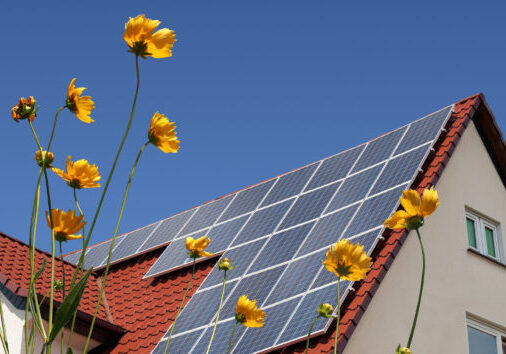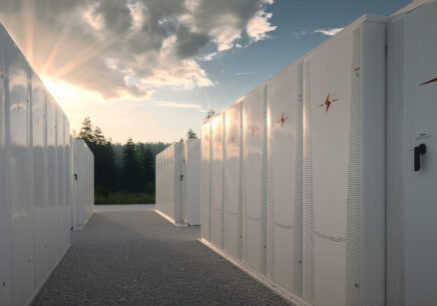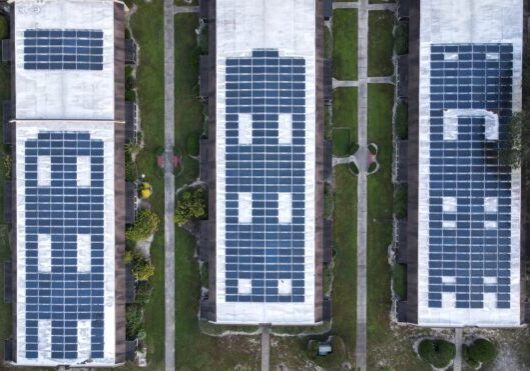October 28, 2025
Batteries, Batteries Everywhere: Battery-Powered Appliances are Reshaping the Electric Grid
By Seth Mullendore
In the not-so-distant past, home batteries were the domain of the early adopters: the solar fanatic with a Powerwall tucked in the garage or the off-grid enthusiast living by their own rules. But that is changing fast. Along with a rapid increase in home battery system installations, batteries are finding their way into the appliances that power our daily lives. Stoves, air conditioners, and electric vehicle chargers are beginning to come equipped with battery systems, and they’re being harnessed to reshape the electric grid.
We’re Cooking with Batteries Now
A couple of years ago, a new induction stove hit the market equipped with a 4-kilowatt-hour battery. While it costs more than other induction stoves, the battery allows the stove to be plugged into a standard 120-volt wall outlet, avoiding costly upgrades to install a higher voltage outlet that is required for most induction stoves. In addition to lower installation costs, the battery stores enough energy to power the cooktop for hours during an outage, and it can also feed electricity back to the grid. The stove even comes with an extra outlet so you can plug in other devices when the power is out. The stove marked a small but pivotal step toward a more distributed and resilient energy system, where every device contributes a bit of backup power and grid flexibility.
The idea isn’t just about convenience; it’s about democratizing our energy system. Traditional home battery systems can cost upwards of ten thousand dollars, putting them out of reach for most households. But if battery capacity comes built into everyday appliances, resilience can become a standard offering rather than a luxury.
These battery-powered stoves made a push into the mainstream earlier this year with a New York Times Wirecutter review. Beyond their sleek looks and precise heat control, the Times review noted something important that points to the fundamental energy system shift that batteries can unlock. The back-end system controlling how the stove’s battery operates is smart enough to charge when energy is cheapest, without the owner having to do anything or change how or when they use their stove. Adding a battery turns your stove into part of an energy solution that can smooth out peaks in household electricity demand and help balance the electric grid during high-use periods.
Air Conditioners That Balance the Grid
Now air conditioners are getting into the game. Air conditioning is one of the biggest energy users in US homes, responsible for huge spikes in demand during heat waves. But what if air conditioners could help prevent blackouts instead of causing them?
Carrier, which has been selling air conditioners since 1915, is rolling out central air conditioning units integrated with batteries and smart controls. These systems can charge up when electricity is cheap or abundant and switch to battery power during expensive peak demand hours, reducing strain on the grid without compromising comfort. Unlike smart thermostats that reduce demand by precooling a home or allowing indoor temperatures to creep up during peak periods, the battery allows Carrier’s air conditioners to continue operating as normal, with no impact on home comfort. The effort is just kicking off with about 15 homes participating in a pilot program, but Carrier plans to scale up participation and have utilities pay for it, in the same way that utilities invest in energy efficiency initiatives to reduce household demand.
Consolidated Edison is already doing this with 65 of its customers in New York City. Each of the participating customers gets a free portable battery system and about $100 for every air conditioner they plug into the battery. The battery itself plugs into a standard outlet and can be used to power other plug-in devices during a power outage. Like in Carrier’s pilot program, the utility switches the air conditioners over to battery power during peak demand periods. Because the batteries are portable, the program can easily be rolled out to renters in any apartment with a plug-in air conditioner.
Pairing air conditioners with batteries could prove to be transformative as climate change drives more frequent and severe heat waves. Instead of millions of air conditioners ramping up simultaneously and overwhelming the power system, distributed batteries could act as shock absorbers, keeping the grid stable and keeping electricity costs down.
EV Charging Gets a Battery Boost
Electric vehicles (EVs) are another major new load on the grid, but they can also be part of the solution when paired with batteries. At its first US site, Autel Energy recently deployed an EV charging station equipped with on-site battery energy storage. The batteries charge from the grid during low-demand periods and discharge to power up EVs during high-demand hours. This approach reduces the need for expensive grid upgrades to handle peak charging loads, lowers electricity costs for operators, and can keep charging stations open during outages.
The same principle can extend to home chargers. Instead of delaying charging to avoid peak periods, pairing EV chargers with batteries allows for the freedom to charge anytime without straining the grid.
Meeting Demand with Distributed Solutions
All of this comes at a time when electricity demand in the US is rising after two decades of relative stability, driven by data centers and electrification. But, as detailed in a recent report from Rewiring America, electrification can also be a part of the solution to load growth. According to Rewiring America’s analysis, widespread deployment of heat pumps, solar, and batteries could offset AI-driven load growth through 2029, while saving households hundreds of dollars on energy bills.
The stakes are high. The market research firm Monitoring Analytics found that load from data centers was the primary reason why energy costs in the PJM region (which serves much of the Mid-Atlantic and portions of the Midwest) have been skyrocketing, passing billions of dollars in expenses on to ratepayers. Battery systems distributed across homes could significantly mitigate these costs by reducing peak demand and the need for expensive new infrastructure.
Taken together, these developments mark a profound shift in how we think about electricity. The grid is no longer a one-way flow of power from centralized plants to passive consumers. Instead, it’s becoming an ecosystem of connected devices, each capable of storing, shifting, sharing, and optimizing energy flows in real time.
When your appliances contain batteries, you can ride through power outages with ease, support the grid during when it’s stressed, and even earn revenue for providing much-needed energy storage and flexibility. This might sound like a futuristic idea, but such a future is quickly becoming a reality. Battery-equipped appliances are already hitting the market as manufacturers realize the value that energy storage can add to their products and dozens of state and utility programs are already tapping into thousands of home batteries to increase grid flexibility and lower operating costs.
It may not be long before the grid of the future reaches your home, and your stove, air conditioner, and car might also be helping power your neighborhood.














